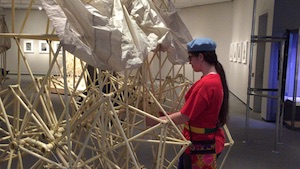The strandbeest as a metaphor for our role in machine evolution
 Theo Jansen’s “strandbeest” creatures captured my imagination. If you like these eldritch and fascinating machines you can copy his plans and make one yourself. Which makes me wonder: are we creating them, or serving them?
Theo Jansen’s “strandbeest” creatures captured my imagination. If you like these eldritch and fascinating machines you can copy his plans and make one yourself. Which makes me wonder: are we creating them, or serving them?
Theo Jansen is an inventive Dutch artist who builds creatures called strandbeests (calling them “kinetic sculptures” doesn’t do them justice) out of tubes of plastic electrical conduit, zip ties, plastic soda bottles, and fabric. Strandbeest means “beach animal.” If you are in Boston, go see them at the always provocative and fascinating Peabody Essex Museum in Salem before January 6.
Jansen’s clever engineering enables the beests to store the power of the wind and then scrabble down the beach like a huge mutant millipede. All the elements are mechanical, not electrical or electronic, with valves and connections that operate based on the movement of air. The otherworldly way they move is difficult to describe. Here’s a video:
Unlike most artists, Jansen has published the specs for his art on line, and you can create your own. So people are building variants on the strandbeest all over the world. Jansen speaks of his creations as animals and, as he told TED, they are evolving with our help.
Anything that evolves needs to reproduce. Strandbeests don’t reproduce like other animals. They reproduce through us. We read the plans, modify them, build new beests, and then publish the plans for those. Are we symbiotic, or are they exploiting us?
Evolutionary biologist Richard Dawkins cleverly reframed evolution in terms of the selfish gene. Instead of species reproducing with genes, he asks us to imagine genes replicating themselves through the creation of organisms to spread them. Dawkins also invented the concept of a meme, which in his formulation is an idea that uses our brains and communication mechanisms to reproduce. (Facebook is just the latest tool that memes have used to facilitate their own reproduction.)
I cannot shake the idea of strandbeests using us to facilitate their reproduction. It has made me wonder if information technology is doing the same thing. Computers have enabled us to create robots. Those robots help build and design CAD devices, 3D printers, and more capable robots that reproduce ever more efficiently. They use our resources — our energy sources, our communications tools, our bodies and our brains — to improve that reproduction. They’re getting smarter. For our own sake, I hope we continue to be useful in their reproductive lifecycle.
Photo: Josh Bernoff at Peabody Essex Museum (features Isaac Bernoff)